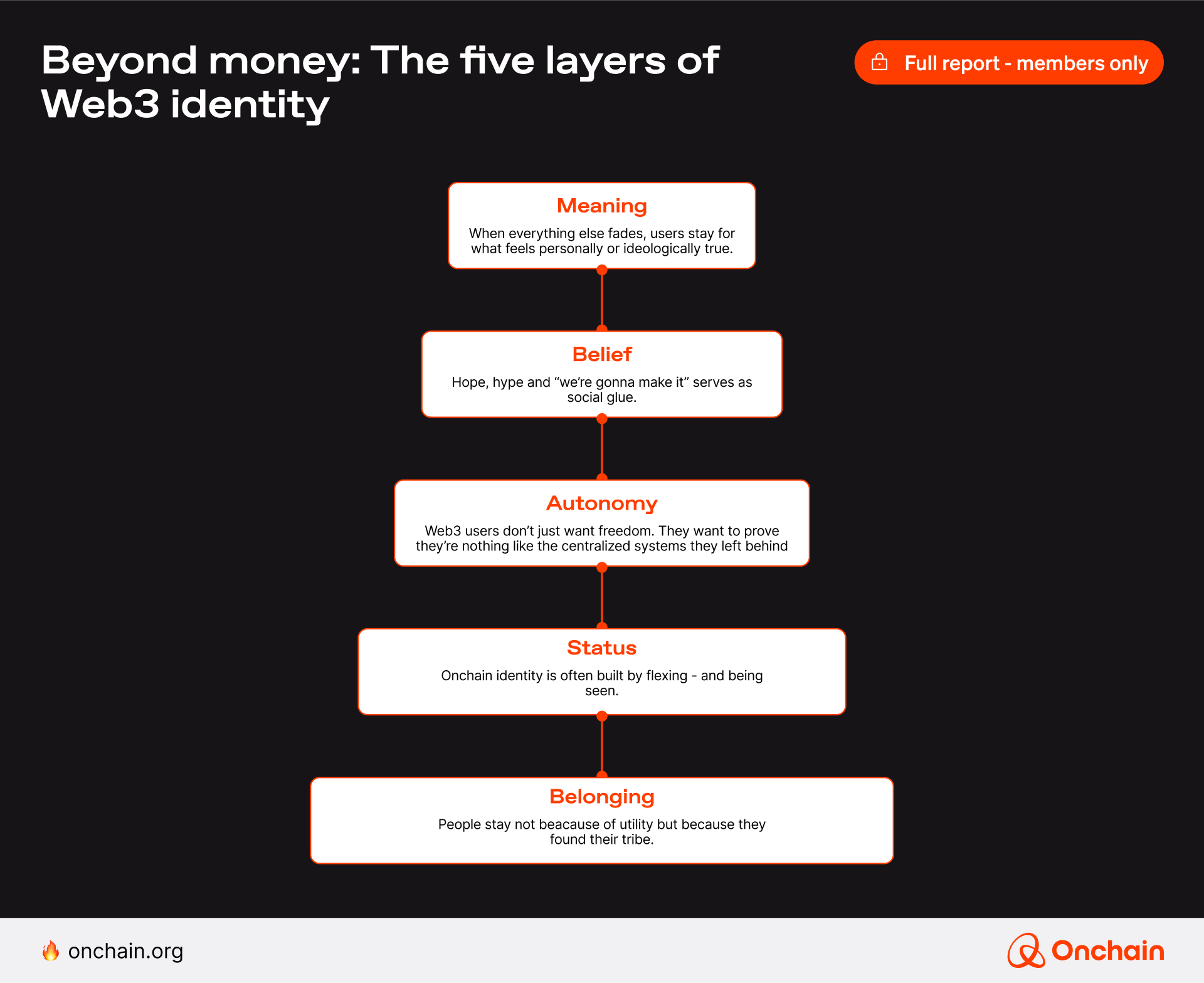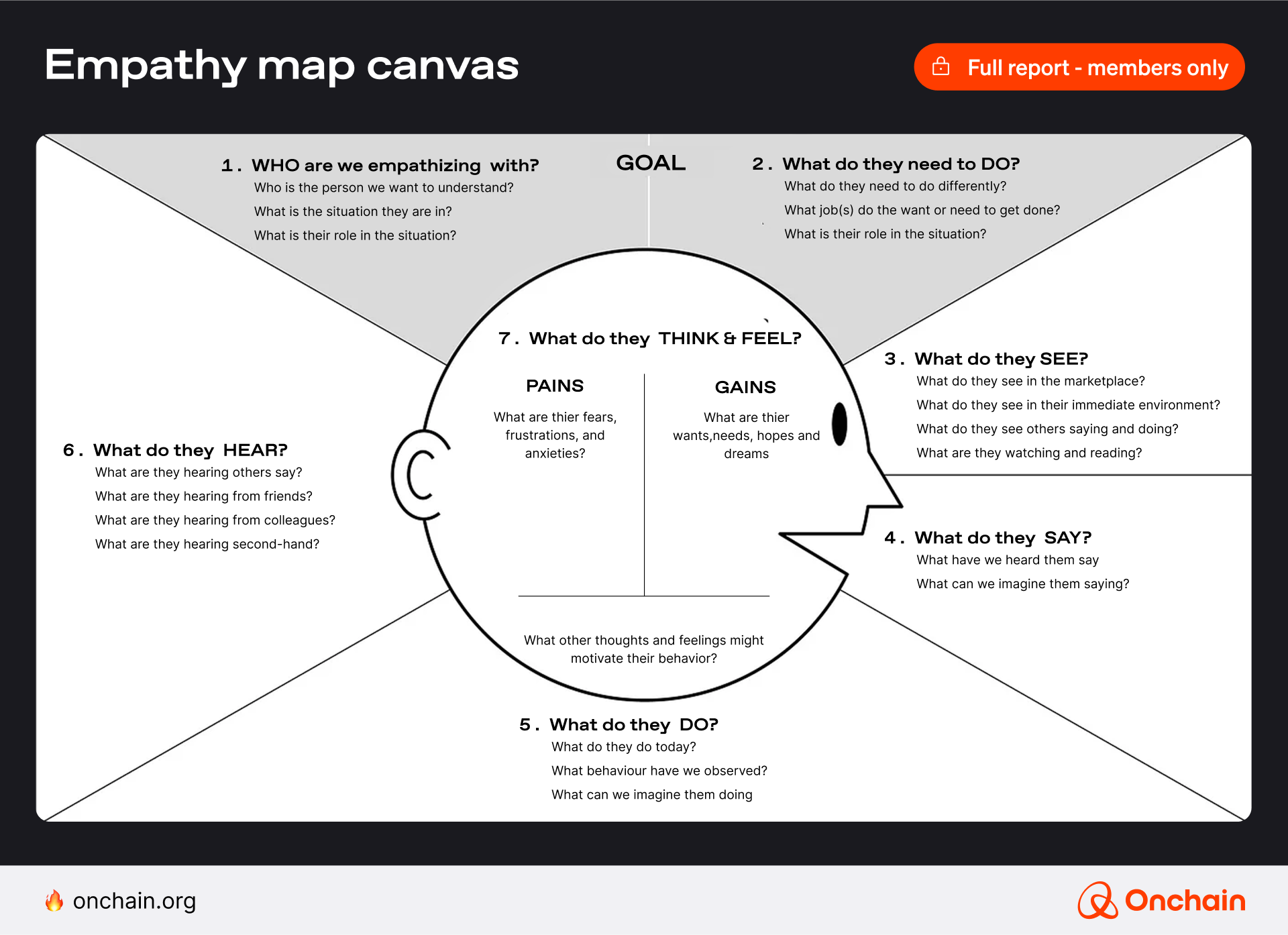Gone are the days where financial incentives alone drive consumer activity. The most competitive projects are those that build on meaning rather than making a quick buck.
Knowing your market from day one will give your project an edge. It’ll gain you dedicated and passionate users who want to see you succeed — and will help you do it.
Michal Moneta is an expert on consumer psychology. He put out a detailed report last month analyzing the mindset of Web3 users and outlining the steps you should take to integrate it in your marketing and retention strategy.
In this article, you find the key takeaways to help you nail it. If you are an Onchain Member, you can read the full report here.
Beyond money: The five layers of Web3 identity

What attracts Web3 users and what will keep them are two different things. The Onchain hierarchy of needs, developed by Michał Moneta, can be thought of as the emotional funnel that converts the curious into the passionate fan club we all desire for our projects.
Belonging: The starting point
We join communities because of shared interests, values, or peer pressure. We want to be where our friends are, fear missing out (no FOMO), and support projects that we believe in. Often referred to as tribalism, this is the first emotional leap your users must make to join your project.
Status: The flaunting point
As a project grows, so does its reputation. How many of us have rolled our eyes when a friend says, “I knew of that band before it was cool,” in order to lowkey brag they’re part of the fan club? We sigh, but status matters. How will your project be the “before it was cool” org?
Autonomy: The Web3 point
After the initial hype, Web3 values start to matter. You’ll see the most attrition from folks who don’t align with your goals and joined due to FOMO; the greatest retention from Web3 users who feel your project is differentiating itself from outdated corporate structures. Make sure you make those features loud.
Belief: The feel-good point
Dedicated fans stick around because they believe in the project’s future. They believe that it will deliver on the values mentioned above and the personal promise made to each member. It’s critical you continue to show them that they can believe in you. Deliver results (or honesty) at every milestone.
Meaning: The true retainer
In the long term, members drive personal identity from their involvement in your project. They stick around because the project became a part of them; both a source of pride and inspiration. This is the difference between Web3 user acquisition and retention.
Put together, these become the difference between a New York City street barker selling counterfeit DVDs and a dedicated fan club membership. The former has most folks crossing the street; the latter has its target market clamoring for entry. Let’s take a look at the mindset of the latter so you can integrate it into your project.
The role of cognitive biases in shaping behavior
Personal bias shapes every action you take. It’s why people are willing to die on the hill of Coke vs. Pepsi, Adidas vs. Nike, Mac vs. PC (I’ll never reveal which side I’m on!).
But it’s more than just brand bias. We choose sides because of cognitive bias based on past experiences, good and bad. What is often billed as intuition is grounded in millions of moments that form one’s preferences.
All this goes into Web3 user acquisition. Understanding your people will help you onboard more dedicated users, sooner.
Social proof
The influencer career has popped off exactly because social proof matters. When your project is in its earliest stages, social proof is very low. You need to consider how to develop it for your project as early as possible. KOLs (key opinion leaders) and influencers are great options when you have a budget. If you don’t, consider your team as the resource. Can they invite their friends and family as testers? And when will testimonials come from? It’s never too early to start this process.
Confirmation bias
Our brains are constantly tuning out information that feels irrelevant. If you’re not careful, you can overwhelm would-be users with too much info. On the flip side, not using key words and phrases that feel familiar to them is a huge miss. People need to feel seen, heard, and understood before they’ll join a project. Language and imagery is an easy way to achieve this early.
Endowment effect
The Endowment Effect is a mental bias toward what one already owns: one is more likely to keep what they have (and fear its loss) rather than make efforts to acquire something new. You can play into this in a few ways.
- Make it feel familiar. If your users recognize what they already engage with in your project, they’re more likely to join.
- Relate your project to what they fear to lose. I don’t mean you should make threats. Rather, explain how your product helps them protect what they have.
Optimism bias
Every industry has indicators that imply success. Successful DeFi projects all have something in common; so do successful app projects and successful art projects. You can take advantage of the common denominator in your industry as your project launches. Look how your users expect a successful project to look. They’ll join your fan club faster.
From data to design: Using tools to decode your Web3 users
The above will get you started with understanding Web3 user acquisition and retention. Now we need the tools that will help you get into your particular user’s mindset so every stage of interaction is tailored directly to them.
Empathy mapping

Empathy mapping is a technique that helps you understand how your Web3 users are thinking and feeling at a given moment. The above worksheet will help you align your messaging with confirmation bias, ensuring your fans know your project is for them. You can get data from secondary research (such as Answer The Public), forums like Reddit or Discord, or 1:1 interviews with avatar users. A mix is best.
Jobs to be done
Contrasting the feelings-driven research of empathy mapping, jobs to be done (JTBD) mapping gives you a sense of your user’s goals and motivations. It’s what they’re hoping your project will do for them. If empathy mapping gives you the tools to onboard a user, JTBD gives you the tools to retain them.
Wallet behavior clustering
Behavior clustering is a mission-critical tool for documenting Web3 user engagement. Thanks to the immutability of the blockchain, you’ll be able to see exactly how your users interact with your project over time. This provides you with a wealth of evidence-based data — including how you might incentivize them to act as you scale.
Decision journey mapping
This is the critical step that pulls it all together. Journey mapping not only documents the stages of Web3 user engagement, it also rates the satisfaction of your users at each stage. Wallet behavior clustering should be prepared for this process, as it will show where attrition occurs and give your team talking points for user outreach.
Why this matters for tokenization and founders
It should come as no shock that bringing people into your fan club (aka. Tokenized Web3 project) takes market research and trust building. Web3 has an additional edge over typical market research because it offers specialized tools, from wallet mapping to token incentives. These all come together to help you:
- Build loyalty by rewarding identity and participation: Design your hype cycle with retention in mind, rather than getting users in the door only to find an empty room beyond.
- Design token utility that taps into status and belonging: Reward users if they were the first, keep them by building meaning into holding and staking their tokens with you.
- Create onboarding flows that address cognitive friction: Your user attrition at onboarding is a project killer. Follow the age-old military saying “Keep It Simple, Stupid.”
- Segment users by mindset to improve engagement and retention: Speak to them in their language and when they expect to be interacted with.
Next steps: Applying psychology for better Web3 design
It’s true that when your technology shines, it speaks for itself. But you can’t just rely on the shiny to bring users in the door. You need to keep them once they’ve arrived. That’s where loyalty programs come in. From point systems to community, an effective loyalty program won’t just retain users, it will turn them into evangelists for your dApp. Move to the next article in the Track to learn more.



